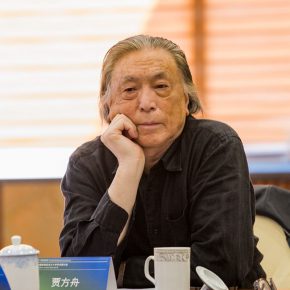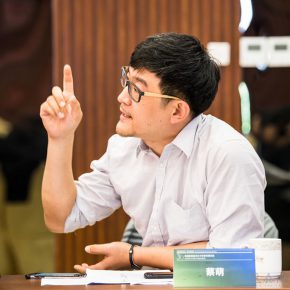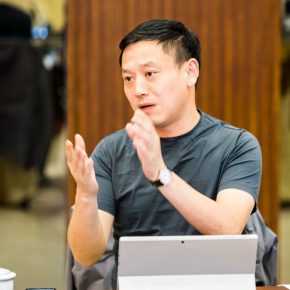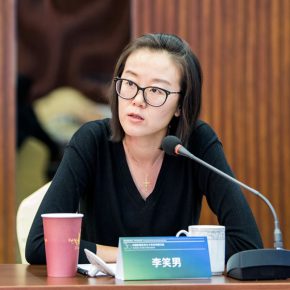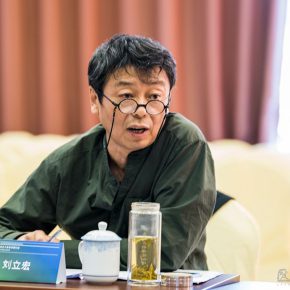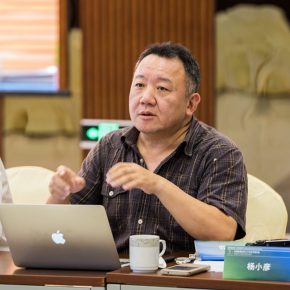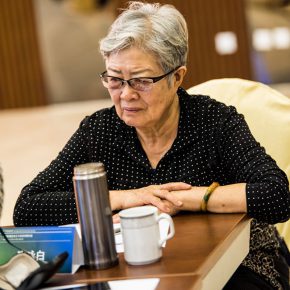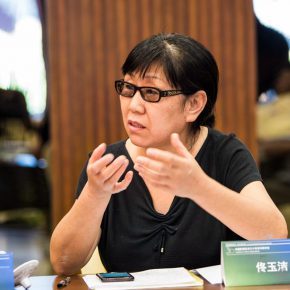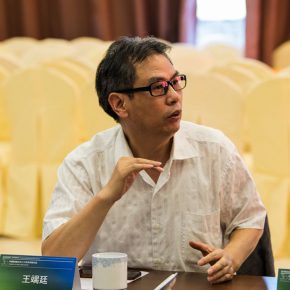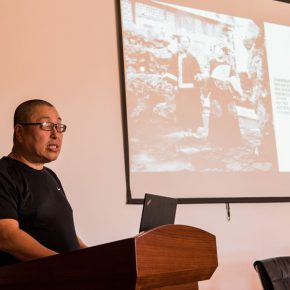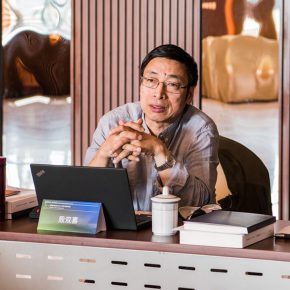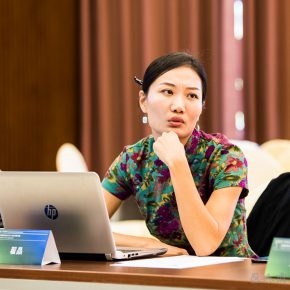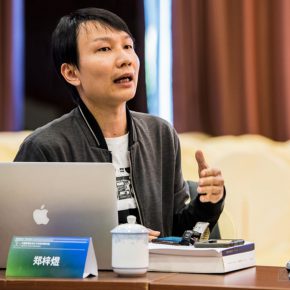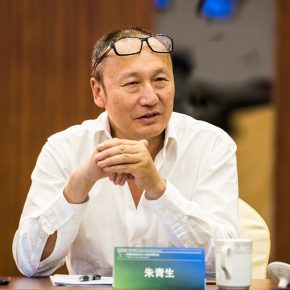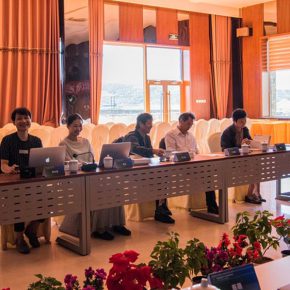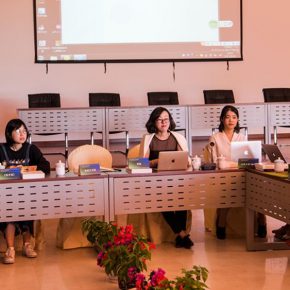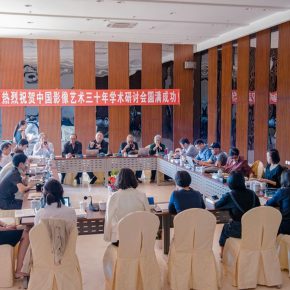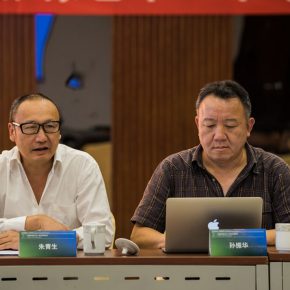
I. Overview
From August 28 – August 30, 2017, a three-day symposium of “The Frontier of Critical Theory: 2017 Cha Er Lake Forum – 30 Years of Chinese Video Art” was held in Cha Er Lake of Ulanqab, in Inner Mongolia. The symposium was co-initiated by Tao Yongbai and Jia Fangzhou. Sun Zhenhua acted as the director of the Academic Committee and Yang Xiaoyan served as the academic chair. Members of the Academic Committee included LaoZhu, Yin Shuangxi, Wang Duanting, Tong Yujie, He Guiyan, Ji Shaofeng.
“The Frontier of Critical Theory, which began in 2014, has been successfully held in Shennongjia, Hubei three times, offering a sifting as well as academic research on “30 Years of Chinese Performance Art”, “30 Years of Chinese Female Art”, and “30 Years of Chinese Installation Art”. This series of forums is based on the critics' perspective and discusses the practice of Chinese contemporary art. In view of the breadth and importance of the video art in the field of contemporary art, in 2017, supported by the Cha Er Lake Development Co., Ltd. and Wu Zuoren International Foundation of Fine Arts, China Art Criticism Foundation focused on the “30 Years of Chinese Video Art”, and gradually improves the main form of contemporary art covered by this series of seminars.
This symposium discusses the “video” in a broad sense, referring to art practices including photography, video, new media art, which originated in photography, rather than a video in the narrow sense. It discusses the artists who continue to use the language of video as a professional media rather than an occasional medium or guest medium.
Nowadays, video is the world. Video is like the most important visual product of the visual era, images have been ubiquitously shaping the spread of information, people’s thought and way of life. Placed in a Chinese context, it began brewing and fermenting with “documentary photography” of the 1980s, affording a magnificent view of the 1990s, while filling the gap in history, it also goes to the inflection point for reflection. Corresponding to it, a practice named “conceptual photography” has slowly become a creative media with great potential, with creators who misappropriated and reconstructed the images to create a conceptual expression, video creation is increasingly recognized as an experiment involved in the imagery, language and communication. Moving image – independent documentary & video art, and static image – “documentary photography” & “conceptual photography” appeared simultaneously, it was called “independent”, because it emphasized the personal position and cultural values of the creator.
Since photography entered the new century, along with the rapid adoption of camera phones and the mobile internet, photography has given birth to a symptom of the times that all people produce and consume images. The image is the world today rather than the medium for people to view the world. The view and creation that takes the image as a medium enters a new stage of “Sci-tech Shaping Society”, in the face of the immortal immersive wonders created by the rapid interactive technological environment, it tries to clarify the past and present of video art in China, as well as the predicament and future, which is significant.
II. Special Reports
The special reports of the symposium lasted about one and a half days with 13 young and middle-aged scholars delivering speeches on the basic theory of photography, the history of photography, the thematic issues of video, cases of video practice, and video teaching.
1. Basic Theory of Photography
Prof. Yin Shuangxi from the Central Academy of Fine Arts, Prof. Wang Duanting from the China National Academy of Arts and Prof. Feng Yuan from Sun Yat-sen University delivered a speech involving the basic theory of photography. Prof. Yin Shuangxi introduced the theme of “Time and History of Video Art”. He quoted Baudelaire’s definition of modernity that “modernity is interim, brief and accidental, half of art, while the rest is eternal and constant”, which also works in video art. He proposed that choosing is delimitation, so that video gives an issue a symbolic meaning, and the criterion of selection becomes one of the topics worth exploring in this seminar. Subsequently, Yin Shuangxi talked about the relationship between photography and painting. When the art moved towards postmodernism, video is also in the “post-image” period, the art of image was innovated, depending on the continuous updating of technology, but technological change can’t cover our pursuit of “heart” in the artistic expression. Now the video is also in the predicament of the classical, elite that requires transforming to the public and daily life like other art categories,which is neglects the stable values. How is a moment converted to eternity is still a problem worthy of pondering for a creator of video.
Prof. Wang Duanting’s lecture was themed on “It Only Takes One Minute: An Overview of Chinese Contemporary Photography, Video and Digital Art as Concept Art”, which is an article written by Wang Duanting when he served as a curator for the “Exhibition for Sino-German Conceptual Art Comparative Study” held at the He Art Museum in Hubei from March, 2015 to June, 2015. In addition to introducing the category of conceptual art and the development process in China, he focused on the generation, development process and features of the three emerging conceptual art forms including contemporary photography, video and digital art in China.
Prof. Feng Yuan delivered a speech themed on “Group Photo and Video Sequence –Visual Sociology of the Video World”, which is more like the “grammar analysis” of video art as a form of language. He interpreted the uncertainty of symbolic code and image viewing of the video narrative, how do we understand the meaning of the moment? As a time slice, the meaning of video lies in the interpretation of the human being. On the basis of the communication science, Feng analyzed the narrative domain and image domain of the video, explained the three procedures of the video and the three procedures of shooting, and obtained the sociological significance of video – the lens shapes a society. Finally, he talked about the core of this speech – what is video sequence? It is a kind of photo economics, the grammar of video sequence is determined by the relationship between the objects of the group photo, with an unique set of methods of vector calculation and semiotic judgment.
2. History of Photography
Prof. Yang Xiaoyan from Sun Yat-sen University and Associate Prof.Cai Meng from the Central Academy of Fine Arts created a monograph and meticulous examination of the history of photography.
Prof. Yang Xiaoyan gave a speech entitled “Photography Entered China”, to profoundly outline a historical picture of photography entering China over the last century. He took Lang Jingshan as an example and started a speech to narrate the cultural phenomenon of the photographers of the Republic of China who were anti-Western (cultural difficulties of the East-West fusion of the Republic of China), anti-photography (to offset the momentary aspect of an image), and then put forward a more important issue: in China, how did the lens build a meaning? In addition, Yang Xiaoyan also talked about the “photographic properties” he is very interested in, analyzing the physical properties of the photographic detail.
Cai Meng gave a speech on “Documentary and Photography: the Alternating Advancement of Contemporary Chinese Photography,” that presents an history of Chinese photography from a macro perspective. He took the photographs of the late Qing Dynasty, photographs of the Republic of China, photographs of the new China (which were also divided into the photographs of “seventeen years”, photographs of the Culture Revolution and photographs of the new period) as the clue of time, to have an overview of representative artists and their works in each period. In addition, Cai Meng also talked about the definition of “what is documentary photography”, “what is conceptual photography”, as well as curatorial practices in the field of photography in recent years.
3. Study on the Thematic Issue of Photography
Prof. LaoZhu from Peking University, Associate Prof. Li Xiaonan from the College of Art at Renmin University of China, Associate Researcher Tong Yujie from Xi’an Academy of Fine Arts, Dr. Zheng Ziyu from Sun Yat-sen University, Ge Xiuzhi from the Art Museum of Tsinghua University completed special research on a variety of problems appearing in the practices of images or anti-images from different dimensions.
Prof. LaoZhu devotes himself to the creation of conceptual art in recent years, in addition to researching and writing. He delivered a speech of “Anti-Image” which is based on the reflection of the self-practice of art. Zhu is interested in the lens “out of control”, and thus doubts the media information previously received, and these edited and screened images reflect the landscape society where human beings are controlled and arranged by the power and capital, which is confronted by LaoZhu using the practice of video. In addition, LaoZhu also talked about “the third art”, which could not be classified as video art, although they were created through an image. The traditional photography or video art focuses on content, while more and more artists only create the means of an image, more emphasis the production process, the hidden concept and the method of showing, so these open cross-media works are difficult to classify.
The young scholar Zheng Ziyu also had a discussion on the observation of current young artists’ “anti-photography” practice, which was similar to LaoZhu “anti-image” theory. Zheng Ziyu’s speech was based on his planned exhibition entitled “Taking a Drastic Measure to Deal with a Situation: ‘Anti-Photography’ Practice in Chinese Image Art”, he cited more than ten artists, whose creations were more or less related with the images, but abandoned the camera, lens, photographic process and other basic elements of photography to a certain extent, and continued to add new materials and media in the creative process to form a unique personal language. It is difficult to define whether it is a photographic creation, but it is worthy of further consideration that “what is it” for the researcher.
In addition, several female scholars delivered a speech on the topics they were interested in. Tong Yujie took the recent popular “self-timer” phenomenon as the starting point, started from the“self-imaging” which is a keyword of self-timer to analyze the content of big and small narrations, and then talked about the “intervention of role” and “transcending of role”. Li Xiaonan gave a speech of “Return and Deformation of the Wound –‘Repetition’of Chinese Contemporary Video Art and the Derivation of Language”, started from the study of the practice of video art since 1988 replaced by the exploration of the internal language of video, and Li recently focused on a more detailed level. Through observing the image practices of many artists, she discovered the language features that were prevalent in many creations – repetition, circulation and the trauma of expression. Ge Xiuzhi then offered a speech on “Sensitive Body – the Study on the Body of Western Female Art”.
4. Studies on Image Cases
Art critic Jia Fangzhou delivered a speech entitled “Love Song by Michelangelo: Geng Xue’s Video Work” and Associate Prof. Zhai Jing from the College of Art at the Capital Normal University delivered a speech entitled “The Pedigree of Power: Yao Qingmei and Chen Yingru’s Video Art”, which both focused on the case of the practice of video art.
Jia Fangzhou introduced the “Love Song by Michelangelo”, which is presented in the form of a video, it records using clay to shape the whole process of life and death. It is full of religious music and flamboyant poetry with divine afflatus, which makes the viewer feel like a heart breaker, form a strong internal conflict between love and desire, tenderness and violence.
Zhai Jing analyses the two female artists Yao Qingmei and Chen Yingru’s and interprets the pedigree of power behind the image of art, artist Yao Qingmei who is from Zhejiang, now living in Paris, her works mainly reflect the deconstruction and funny irony of power, Taiwanese artist Chen Yingru’s power trio cuts into the viewing of power from the perspective of mysticism.
5. Researches on Image Teaching
Prof. Liu Lihong, Director of the Department of Photography from Lu Xun Academy of Fine Arts, gave a report on “Inheritance and Breakthrough: Three Phases of Photography Teaching”, and introduced the teaching history of the Department of Photography at Lu Xun Academy of Fine Arts, expanding the perspective of theory and criticism to studies of teaching.
III. Topics for Discussion
In the discussion time after the end of each stage of the special report, the participants had a fierce debate on the topics of “Anti-Image” and “Anti-Photography”, “Concept and Boundaries of Image Art”, “Language Standards of Image Creation”, “Documentary Photography” and “Conceptual Photography”, “Image Art of Contemporary Artistic Context”. On this basis, the host Sun Zhenhua and experts & scholars came together to put forward the issues of image art they were interested in, and ultimately formed ten issues, offering an in-depth discussion in the second half of the discussion part.
IV. The Discussion Waiting to Have a Conclusion
Due to the shorter preparation time, the number, background and structure of participants was not complete, combined with thetime limit of the meeting, this seminar left a lot of unfinished business. These scholars were not afraid to break the routine, and had a more rigorous academic attitude, respecting the unfinished discussion, and planned a choice of time to hold a seminar again in order to complete the selection.
After the end of a series of seminars of “30 Years of Chinese Video Art”, the academic committee is also about to collect the submitted papers, memorabilia of video art in China since the 1980s, summaries and pictures of the meeting, the 30 most influential works of Chinese video art in the past 30 years, to edit & publish a collection of theories and criticisms of “Chinese Video Art”. For video art that is a new and ever-changing art category, it has a broad remit and unlimited possibilities in the future, and perhaps it is as the scholar Yin Shuangxi said: the work unfolded by the seminar was only a start.
Text by Zhu Li, translated by Chen Peihua and edited by Sue/CAFA ART INFO
Photo by the organizer


